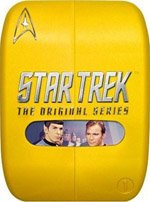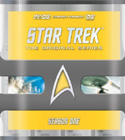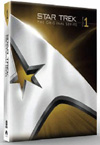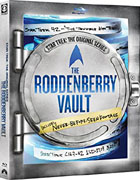The Corbomite Maneuver
For the actual weekly Star Trek series, production began with this episode -
primarily a shipboard show in which the crew encounter and confront a large
and powerful unknown species in an uncharted region. Though nowhere near as
eventful as the two previous pilot episodes, this one is successful in
creating and maintaining a tense standoff for the main drama, while finishing off
with one of the most successful celebrations of Star Trek philosophy that
can be found in Trek's earliest episodes.
It actually made a lot of good sense to shoot this episode first in the weekly
schedules. This allowed the production designers to really focus on getting
the Enterprise sets and costumes right, after which principle photography
would be relatively easy and straightforward. Only one small "swing set"
was required for the ending and a few inserts. This episode sees some welcome
expansions to the sickbay and the Captain's quarters which will benefit all
subsequent episodes. However, with all the principle photography in the can,
the episode was still far from ready. "The Corbomite Maneuver" required a lot more
model and optical shots than most other episodes, so it isn't surprising that
it languished in post-production longer than usual, eventually taking the 10th
broadcast slot. Its opticals turned out to be quite good in the end, with some
of the trick composites giving the episode an enormous sense of scale, nicely
coupled with the very "big" sound of Fred Steiner's music.
Though it's not a bad idea to save this big encounter until part-way through
the season, I still prefer to watch this as the third episode since it is
introducing us to the rest of the regular Enterprise crew for Season One.
Episode Three's biggest addition to the line-up is undoubtedly
Dr. Leonard "Bones" McCoy, who spends most of his time in this episode
demonstrating his relationship with Kirk while discussing the crew in general
and the main guest star in particular. Kirk and McCoy most definitely have
a pre-existing and comfortable, warm relationship that they enjoy, one that makes
compelling viewing. It's in much the same vein as Captain Pike and John Hoyt's
bartending doctor from
the first pilot "The Cage", and equally if not more
successful, while the age difference between Kirk and McCoy perhaps works a bit better
for what the writers had envisioned. It's easy to like McCoy from this episode
and get on board with him here. He's clearly the physician in his first scene,
getting in the first of his infamous "I'm a doctor" career contrast lines,
but he actually spends most of his time in this one performing duty as
ship's psychologist, looking out for crew morale. And though he has one moment
of getting on Kirk's case at an inappropriate time, he's pretty quick to notice,
apologize, and make amends... and the moment also goes on to inspire Kirk
to invent the winning tactic that the episode is named after.
Also notable is the first appearance of Lt. Uhura. To be fair, she doesn't
get a heck of a lot to do in this story beyond performing her job adequately,
but it's reassuring to see the familiar faces of the crew come together here.
Uhura turns out to be the only member of the cast who has not yet found the
correct colour for her uniform yet - another indication that this is still
early days for the show.
In actual fact, she bumped our main guest star Mr. Bailey from his position
as communication officer, making him the navigator for the episode. At times,
one may wonder how Bailey got this position, considering how he behaves,
but it's not too hard to accept when one considers he was probably quite
a quick replacement for Gary Mitchell.
The last major addition to the crew for this episode is Grace Lee Whitney
as Yeoman Janice Rand. Though she turns out to be a very important character
for many of these early episodes, she ends up with a smaller and more understated
role in this episode, though she at least gets enough scenes and screen time
to make a memorable and favourable impression. And it's nice that it does seem
that Kirk is just getting used to her presence aboard ship in this one.
For those of you wondering where Ensign Pavel Chekov is, well, he's probably
still in his final year of studies at the Academy, because he won't make
his debut on the show until next season.
Because this is primarily a shipboard show, and one that has a lot of tense
and dramatic "waiting time" in it, we do get a lot of chances to merely observe
our crew discussing matters with each other, demonstrating who they are as
characters - and they all seem to benefit quite a bit from this approach.
Mr. Spock, Scotty, and Sulu are all back from the previous story as well,
all getting increasing depth of character and seeming much more like the people
we all grew to love as the show progressed. Mr. Spock makes his half-Human
heritage known in this story (a step up from the second pilot's implication
that he might be something like 1/16 Human),
and catches himself almost expressing an emotion.
His catch-phrase of "Fascinating!" also begins here.
This story is quite successful at having its cake and eating it too. The main
external confrontation literally feels like a very big deal, as though we're
encountering a race and civilization that are a real force to be reckoned with.
Their spacefaring technology appears far more advanced and powerful than that
of Kirk and company, giving them the upper hand. Our first images of Balok
on screen, though primitively realized, are also quite effective. We see a figure
that is very non-Human, likely quite tall, and in demeanour appears to be
quite severe, matching his very stern position in the scripted dialogue.
A kind of underwater rippling effect over the screen works to help mask the
simple production methods used to create this creature for his full motion scenes,
and gives him a more organic believability while also raising questions about
what kind of atmosphere his race requires to live in.
I think we should also acknowledge
the undistorted still image of him that also graces many of the end credit
sequences of other episodes, where he also has quite an impact. If you see
any of those shows first, you may indeed begin to anticipate and look forward
to Balok's episode with baited curiosity, which is all to the good of the show's
success.
This big confrontation is quite organically and believably worked out, taking its
time and not being afraid to go for the obvious early on, and then see where that
would naturally lead the characters.
Best of all, our protagonists' choices at the conclusion of this adventure clearly
stamp the highest ideals of Star Trek philosophy onto the show. Having defeated
the dangers, they prudently stand ready to assist and pursue friendly relations,
and the story's final act indulges them, revealing in great detail what a likeable
softie Balok truly is at heart. Yes, we get the first of many examples of
Star Trek's staple "It's a test!" clichés making sense of what happened
earlier in the episode, but I feel that this one works better than most,
and the payoff this time around is well worth it. Balok's friendlier alter ego is
once again a pretty good way of achieving otherworldliness, giving Ron Howard's
younger brother Clint some early cult fame. Funky stuff.
If perhaps the Enterprise crewmembers go too far in trusting Balok's turnaround
so soon, for me it is symbolized by sharing a drink of the orange-juice-like
"Tranya" with him. As a child that part always freaked me out a bit, and seemed
as tense a moment as the earlier ship-to-ship standoff. It could be a deliberate
attempt to poison the landing party. On the other hand, it could be a drink that
is perfectly palatable to Balok's species, offered in a genuine gesture of
friendship, while Balok is ignorant of the fact that it is completely toxic
to Humans. For a first contact between two new species, it seems there's
a necessary scientific step of figuring out how compatible the two species'
diets are. That step gets skipped here, in the interests of diplomatically
sparing Balok's feelings, and it often creeped me out a bit. Couldn't McCoy
have run his medical tricorder over a glass of Tranya first, and commented
on what was in it? Or would that have offended their host? A minor nit
at best these days.
Though this may at times seem to be one of the slower episodes of early Star Trek,
it doesn't commit any major sins, and celebrates the natural facets of
all the regular characters. Most importantly,
I think both its power and its philosophically on-the-money ending give it quite
a strong boost into the upper echelons of early Star Trek's better episodes.
Read the next Star Trek review:
"Mudd's Women"
|
|

















